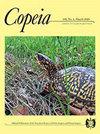A New Species of Snakehead (Teleostei: Channidae) from East Khasi Hills, Meghalaya, Northeastern India
IF 2.6
Q2 Agricultural and Biological Sciences
引用次数: 2
Abstract
A new species of colorful snakehead from Meghalaya, northeastern India is distinguished from all its congeners by possessing a uniform bright blue to bluish-green body, bright-blue dorsal, anal, and caudal fins, submarginally black with white distal margin, series of brown to maroon-red, rounded, oblong or clover-shaped blotches or spots on dorsolateral, postorbital, and ventrolateral region of head, continued on body forming oblique pattern or randomly distributed. The new species superficially resembles C. pardalis and C. bipuli in appearance, but it can be distinguished from both in having brown to maroon-red, rounded, oblong or clover-shaped blotches or spots on head and sides of the body (vs. possession of well-defined, black to brown, rounded to oblong spots), fewer pre-dorsal scales (7 vs. 8–9), more caudal-fin rays (15 vs. 13), and more vertebrae (49 vs. 45). The new species differs from both C. pardalis and C. bipuli by Kimura's two-parameter (K2P) distance of 4.2–4.8 and 4.9–6.0% in the coxI gene sequence. A key to the snakehead Gachua group of the Eastern Himalayan region is provided herein.标题印度东北部梅加拉亚邦东卡西山蛇头一新种(梭鱼科)
来自印度东北部梅加拉亚邦的一种新的彩色蛇头,与所有同类不同,它具有统一的亮蓝色到蓝绿色的身体,亮蓝色的背鳍、肛门鳍和尾鳍,近边缘为黑色,远端边缘为白色,头部背外侧、后腭和腹侧区域有一系列棕色到栗色的圆形、长方形或三叶草状的斑点或斑点,在身体上形成斜纹或随机分布。新物种表面上与C. pardalis和C. bipuli外表相似,但在头部和身体两侧有棕色到栗红色、圆形、长方形或三叶草形状的斑点或斑点(相对于拥有明确的、黑色到棕色、圆形到长方形的斑点)、更少的前背鳞(7比8-9)、更多的尾鳍鳐(15比13)和更多的椎骨(49比45),这两者可以区别开来。coxI基因序列的Kimura双参数(K2P)距离分别为4.2 ~ 4.8和4.9 ~ 6.0%,与C. pardalis和C. bipuli均存在差异。本文提供了东喜马拉雅地区蛇头Gachua群的钥匙。
本文章由计算机程序翻译,如有差异,请以英文原文为准。
求助全文
约1分钟内获得全文
求助全文
来源期刊

Copeia
生物-动物学
CiteScore
2.10
自引率
0.00%
发文量
0
审稿时长
6-12 weeks
期刊介绍:
Founded in 1913, Copeia is a highly respected international journal dedicated to the publication of high quality, original research papers on the behavior, conservation, ecology, genetics, morphology, evolution, physiology, systematics and taxonomy of extant and extinct fishes, amphibians, and reptiles. Copeia is published electronically and is available through BioOne. Articles are published online first, and print issues appear four times per year. In addition to research articles, Copeia publishes invited review papers, book reviews, and compiles virtual issues on topics of interest drawn from papers previously published in the journal.
 求助内容:
求助内容: 应助结果提醒方式:
应助结果提醒方式:


